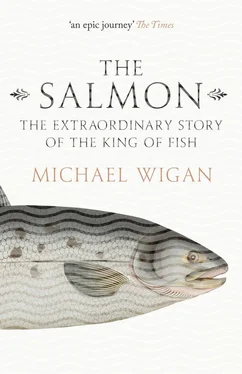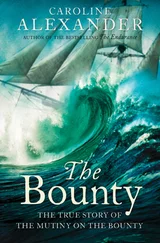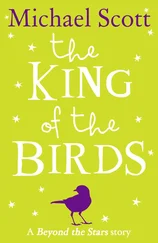It is an extraordinary thought that physically similar fish, at the same development stage, vary in age by so much. There are no obvious parallels in bird or mammal biology. Possibly there are comparable patterns in other fish, but none comes to mind. Salmon evolution is supreme adaptation.
What happens after the entry into seawater has recently been tracked in an internationally funded programme codenamed SALSEA-Merge. SALSEA is the most remarkable research on a fish at sea in recent time. The European Union, Canada, the USA, the Total Foundation in France, the Atlantic Salmon Trust in the UK and a variety of universities and agencies combined to fit out the RV Celtic Voyager and two other vessels with proper equipment, and then put the right people on board who knew what questions to ask and how to get answers.
The results fill in another corner of the lifestyle jigsaw.
The research boats spent three years catching around 27,000 juvenile salmon from 466 different locations in the North Sea, the Norwegian and Irish seas, and generally in the north-east Atlantic around the Faroe Islands and Iceland. Information from 284 out of Europe’s 1,700 salmon rivers from nine countries was used in genetic sampling and analysis. The biggest sample came from Scotland, followed by Norway. By targeting the most productive and the largest rivers, the SALSEA team reckons that 80 per cent of Europe’s productive salmon area was embraced by the research effort. The resulting picture then is a clear story about European salmon, including Russia and Scandinavia, up to 2011.
The novel side of the analysis was the use of genetics. Only recent science allows researchers to find out where a fish comes from. Work on Ireland’s River Moy had already shown what a sprinkling of other rivers had found too – that inside their catchments salmon stocks can be divided up into genetically discrete populations. It was true of a minority of rivers, but demonstrated the impressive complexity of salmon adaptation.
The Atlantic salmon in some form or other has been occupying European and North American rivers for 60 million years. In that immense time it has developed local strains to adapt to local conditions. Then the last Ice Age ended, with a thaw that peeled back the ice-covered land over all Britain north of London. A mere 15,000 years separates us from the frigid conditions that dominated before. In cosmic terms it is a blink in time. Salmon saw pristine territory opening up in front of them, and occupied it.
Rivers in Scotland have plenty in common with other rivers in salmon range. They are spring-fed. These springs can come from hundreds of feet below ground and each one has a differing chemical composition. Also, the springs bubble from the ground loaded with different temperature readings, dependent on their depth.
Variations between springs account for differing populations of salmon. For the scent in each stream, and the mineral contents, differs from that of its neighbour. Salmon have brilliant olfactory senses, being able to pick out the most dilute odours from home-stream chemistry even through a fog of additives and man-made complexities. The fish’s ancestors have used that water and over time adapted to it.
Sometimes that adaptation will translate into an identifiable genetic type. SALSEA went to sea armed in advance with the genetic map of many rivers. The researchers were hunting smolts, young salmon entering an alien saltwater world pregnant with feeding and with threat. What galvanised researchers to go to all this effort? The answer to that question is both simple and complex. At the simple level, it is because the salmon is important enough to justify it – it is a glittering symbol of environmental wellbeing. The complex answer backtracks in time.
In the 1960s European rivers had seen prodigious runs of salmon. The silver bonanza from the spring tides re-ran the programme of fresh shoals arriving through the year and it seemed as certain as the sun dropping in the west that from the start of spring these great leaping, wild, sparkling fish would go on and on revitalising rivers which had gone doggo for the winter.
Then a decline commenced. Fewer and fewer salmon came back in the 1980s, and then the 1990s. The canaries in the mine, or anglers, found their enticing presentations drifting across the stream undisturbed. Nothing jumped. Nothing swirled at the fly. The waters rolled to sea unruffled. The rivers missed their most dramatic occupant.
A few rivers had installed fish counters, usually consisting of electronic beams broken by an upstream-swimming fish, and these counters, logged by computer, were telling an alarming story which backed up the anglers’ perceptions of fewer silver visitors.
It was estimated that in the 1960s and 1970s the population of salmon in the eastern Atlantic was around eight to ten million fish. In America and Canada, where many rivers had been dammed, where forest clearance in river-country had silted up river-beds and traumatised ecosystems, there is another story of dwindling fish, but we will revisit that side of the tale later.
The decline from abundance was giving rise to serious worry.
In places where smolt survival was being measured, such as at Scotland’s North Esk government monitoring station, and the Bush and Burrishoole system in Ireland, young sea-going smolts had once returned as salmon in numbers approaching 15 per cent of the outgoing migration. This figure was falling and falling steadily. It fell to eight and then as low as five per cent. On the River Conon in the northern Scottish Highlands, where they can measure these things, the return rate of smolts in 2011 was four per cent. In some rivers the number will be even less.
For anadromous fish, which live at sea and breed in freshwater rivers, this figure was low – very low. It told scientists that ocean-wide changes were occurring. Somewhere out there a black hole was consuming the small silver fish that used to fatten in the larder of the north-east Atlantic, before returning to their birthplaces in the pebbly streams. In some American rivers spawning pairs were down to a handful of pairs, a chilling brush with death equal to a doomed scenario.
The most obvious subtractions from salmon runs were then looked at and addressed. Salmon netting, which was recorded as having been prosecuted in some parts of the UK and Europe since the twelfth century, was an obvious target. Here was an industrial-scale subtraction, taking fish before they could breed. Furthermore, it violated one of the tenets of modern fisheries management – that you must know what stock of fish you are taking.
Netsmen took salmon offshore as they migrated past. No one had a clear idea which rivers they were due to swim into. A salmon in the net was a salmon in the net; they all looked much the same. They fetched the same price, too. Logic demanded that random salmon capture cease. On the back of the idea that netting was ‘indiscriminate’, harvesting individuals valuable to species survival alongside those from more numerous components of the migration, appeals were launched to save salmon by buying out or leasing netting stations. Many were laid off and mothballed and bought out. In Scotland alone the catch by nets was ratcheted down from around 100,000 salmon a year in 1990 to 13,000 twenty years later.
Salmon netting still exists in a few places in 2013. Norway remains unreconstructed about salmon netting. Scotland has a handful of active netting-stations, resistant to being bought off and encouraged by rising wild salmon prices, England even fewer. The Norwegian Saami people from the far north, with precious little to sustain them, still net salmon on the Arctic coast. In a conservation milestone for salmon, Iceland terminated netting at sea as far back as 1932. Pressed by the European Union, the west-coast Irish drift nets were outlawed in 2007.
Читать дальше












